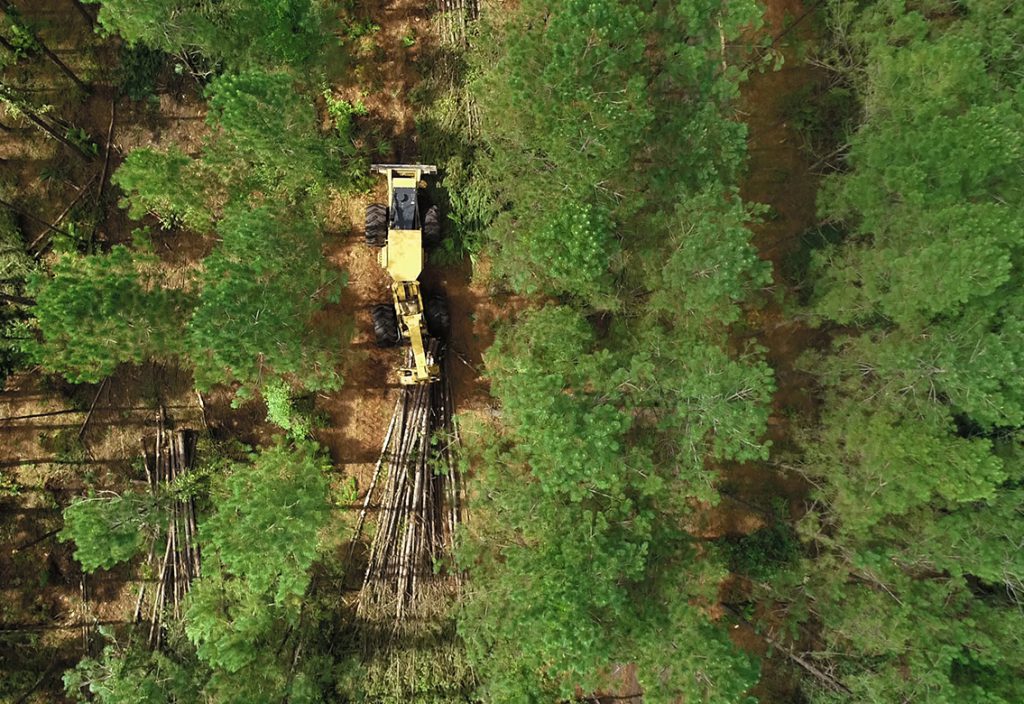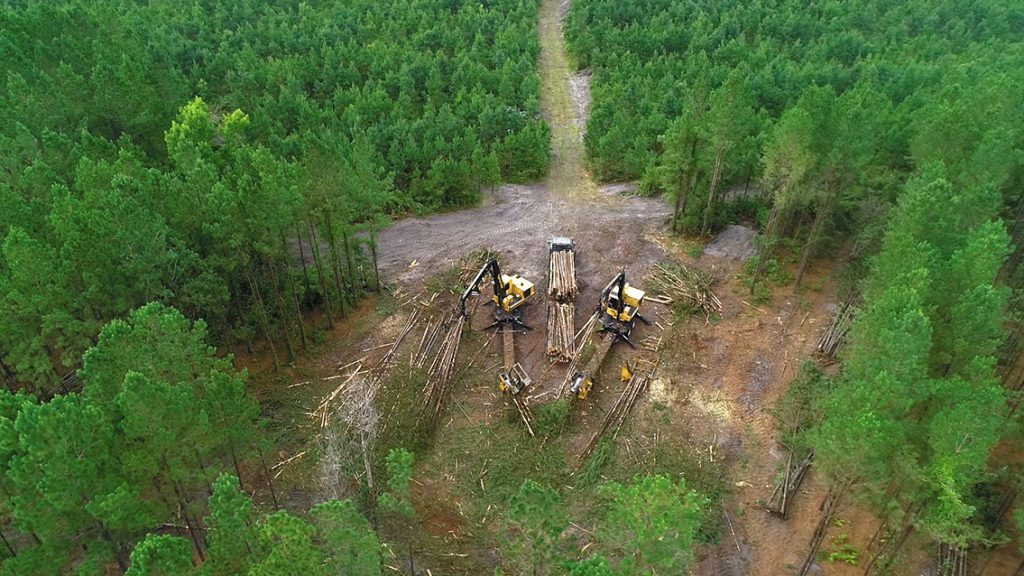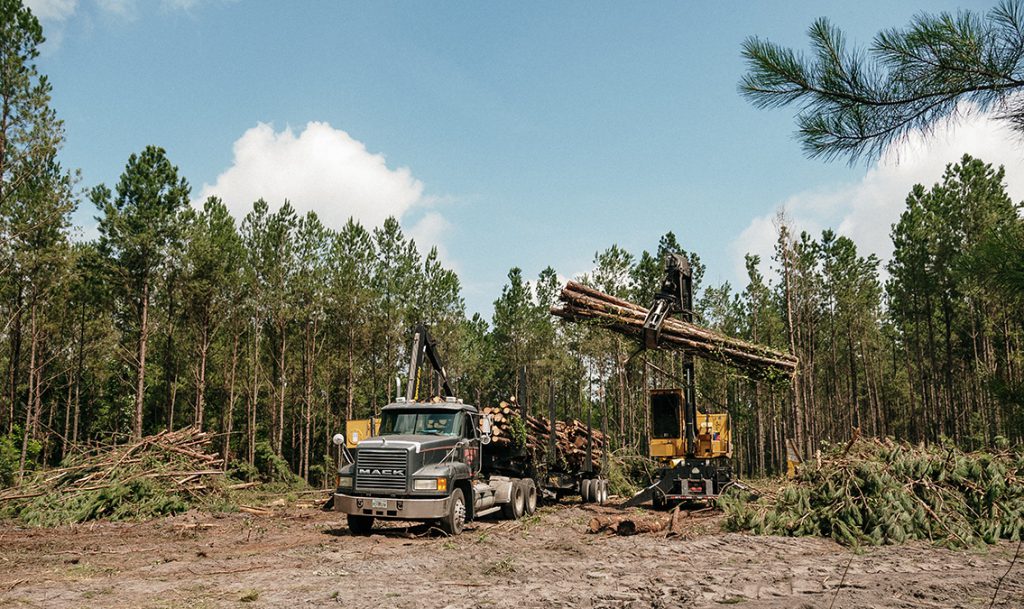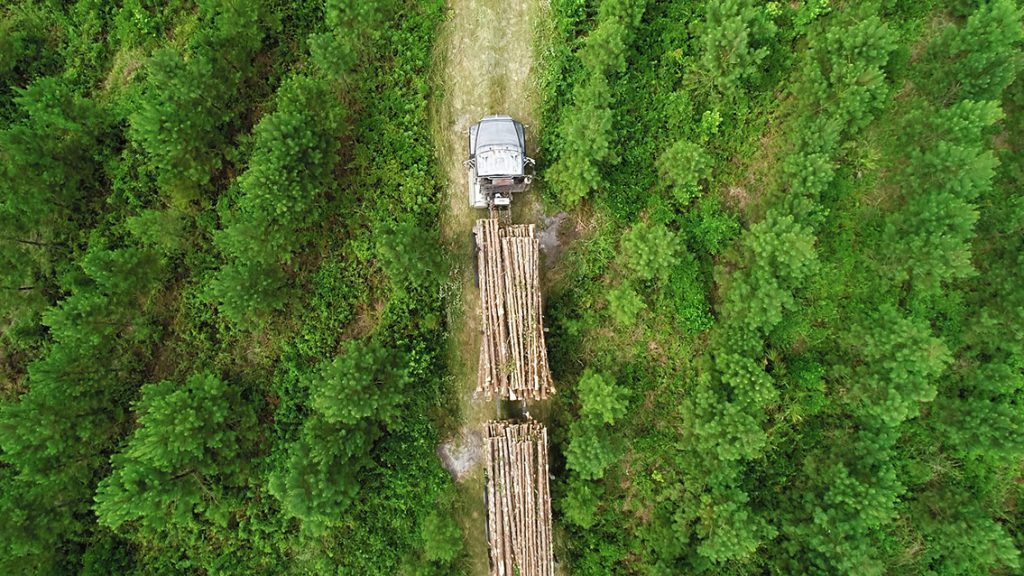Thinning trees is a common practice in forest management that removes full rows of trees. We take you into the forest to show you how, much like weeding a garden, this operation has important benefits for our crop trees.
KINGSLAND, Georgia—A row of south Georgia pines appears to be on the move as an aptly-named feller buncher saws through more than a dozen trees in a row, gathering them in its claw-like grip while they’re still upright.
Once the buncher is at capacity with a large bundle of pines, it lowers them to the ground and drags them out of the forest in one trip, careful to leave neighboring rows of trees unharmed; what remains will be growing for years to come.
This is a thinning operation, and only a portion of the trees will be harvested.

WHAT IS THINNING TREES?
Believe it or not, thinning trees is one of the healthiest activities that can be done for a growing forest. Once trees have matured to a certain age—here in this Georgia forest, they’re about a decade old—they begin to compete with each other for nutrients, water and light. Full rows of trees are removed, allowing the remaining pines to grow to their full potential over the next six to eight years.
In addition to removing full rows, a thinning operation will pick off less desirable trees from the remaining rows.
“We remove trees that are small, forked, diseased. Any trees with defects,” explains Resource Land Manager Josh Steiger.
What remains to grow in the forest are the healthiest, strongest trees with the highest potential to become the products future generations will need, from poles for docks and utilities, to lumber for homes, to the wood used in furniture and countless other products.
“Thinning is a big part of what we do. It allows the crop trees to grow and expand into the solid wood product that we want when we clear cut that stand. We want to have a lot of really good options for whatever our customers will need,” Josh explains. (“Crop trees” refers to trees that will be managed to full maturity and then marketed for their highest and best use).
Similar to weeding a garden, the removal of trees in a thinning leaves the forest less crowded so light can reach more of the tree canopy, and nutrients and water aren’t so hard to come by. After all, there are no sprinkler systems in the forest: there’s only so much water to go around.

WHAT HAPPENS TO THE TREES THAT ARE REMOVED IN A THINNING?
After growing for about 10 to 14 years, the trees removed in a thinning have an important role to play. The majority will go to pulp mills, where they will be processed into the pulp substance that is used in thousands of everyday products, such as paper, cardboard, fabrics, bath products, rubber tires and LCD screens.
WHY NOT PLANT LESS TREES IN THE FIRST PLACE RATHER THAN THIN LATER?
Foresters plant a certain number of trees per-acre with the full knowledge that some of those trees will later be thinned from the forest. In the meantime, those trees help develop a healthy forest in a number of ways:
- First, they help stabilize the soils when seedlings are first planted in the freshly-tilled ground.
- Secondly, when trees are planted closer together, they tend to grow tall rather than wide, with less branches on their trunks. This is important for the quality of the wood of the trees that will grow to full maturity: less branches means less knots in the wood, making a stronger and more attractive product.
- Third, as mentioned above, the trees that are removed play an important role in the forestry industry, supplying much of the wood needed in pulp production.
- And, finally, the trees destined for thinning offer the same environmental benefits as all trees while they grow: sequestering carbon, filtering water, stabilizing soils, providing shade and a host of other benefits.

WHAT WOULD HAPPEN TO A FOREST IF THE TREES WEREN’T THINNED?
“We know that any given acre of land can only grow a certain amount of fiber,” Josh says. “If we do not thin, when that stand reaches its capacity, something that’s very common is what we call ‘self-thinning.’ The trees that are less vigorous will start to die.”
When the forest self-thins, it can be more vulnerable to disease and insect infestations, which can “absolutely devastate” a stand of trees, he says.
How does thinning trees impact wildlife and plant life in the forest?
Thinning a forest can have a significantly positive impact on wildlife and plant life in the forest. When a stand of pines needs to be thinned, the thick cover of treetops—known as the overstory—blocks almost all sunlight from reaching the forest floor. That prevents most plants—or, understory—from growing on the forest floor. After a thinning, shrubs and bushes that foraging animals seek for shelter and food become more readily available.
WHAT HAPPENS TO THE FOREST AFTER A THINNING?
Once a forest is thinned, the remaining trees will often be fertilized to give them a boost as they now have space to grow. But, for the most part, with more light reaching their leaves, more water reaching their roots, and more nutrients to go around, nature will take its course and the trees will naturally grow into a more robust, mature forest.
FOR FURTHER READING ON THINNING TREES:
Tree Thinning 101, by the American Forest Foundation
Thinning my Forest, Partnership for Forestry Education










Join the Conversation
We live in Pages Dairy and I noticed the other day that there were blue paint rings around some of the trees in my back yard. Can you please tell me what the purpose of that is?
Edward, the paint rings are done by surveyors to mark the boundaries of Rayonier land.
Thanks for explaining what would happen if trees weren’t thinned. My uncle purchased land with dense trees and vegetation. I’ll encourage him to work with a ground maintenance service to clear some of it out.